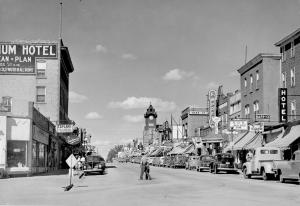
City, pop 13,190 (2006c), 13,692 (2001c), is situated on the north side of the North Saskatchewan River opposite the town of Battleford, approximately 140 km northwest of Saskatoon, and 140 km southeast of Lloydminster. Founded by the Canadian Northern Railway in 1904-05, North Battleford is today served by a municipal airport and five highways: the Yellowhead Highway, and Hwys 4, 26, 29, and 40. It had been fully expected that the Canadian Northern Railway would construct their line across the province though the well-established community of Battleford on the south side of the river; however, history once again passed Battleford by when the railway was surveyed to run along the river’s north side, and a new townsite was surveyed. North Battleford was launched into being, becoming one of the fastest growing centres in the west. To the indignation of the established south shore town, the new site was named “North Battleford,” and it quickly surpassed the older community in size and importance. Battleford, with a history dating to the 1870s, once the Territorial capital, was left to remain a modest town, while North Battleford gained village status on March 21, 1906, became a town within four months, and became the province’s fifth city on May 1, 1913 – the first city declared as such by the Government of Saskatchewan. Growth in the countryside was equally as dramatic: over 1905-06, homestead entries in the district were filed at the rate of about 400 per month. By the early 1920s, however, the boom period was over and North Battleford’s population remained level at somewhat under 5,000 for the next 25 years. In the 15 years following WWII, the population then doubled, and through the 1960s, 1970s, and 1980s the city continued to grow. Today, approximately 20 per cent of North Battleford’s residents are of First Nations or Métis ancestry. Over the course of its history, North Battleford has grown to become a key service, distribution, and receiving centre for the province’s northwest. Agriculture, lumber, and fishing were the traditional components of the economy; oil and gas is of increasing importance, and today a number of companies in North Battleford provide services to the industry. At the beginning of the twenty-first century, the Battleford’s were witnessing a record number of new construction projects: no fewer than 17 condominium and housing subdivisions were underway in 2007, and during the first years of the millennium “big box” retailers such as Wal-Mart and Canadian Tire, and major national franchise ventures such as Staples and Boston Pizza were either building brand-new operations or were expanding existing ones. Battlefords Union Hospital, the Saskatchewan Hospital, and the Battlefords Mental Health Centre are the city’s major medical facilities, and North Battleford has nine elementary schools and three high schools. Northwest Regional College offers post secondary programs and first year university classes. Centennial Park, an 80-acre site in the heart of the city, is a hub of recreational and sporting activities. The park consists of the Lions Stadium baseball complex, a civic centre and an aquatic centre, track and field facilities, soccer and horseshoe pitches, lawn bowling greens, and tennis courts. North Battleford attractions include the Western Development Museum, the Chapel Gallery, the Golden Eagle Casino, the North Battleford Golf & Country Club, and the internationally-recognized collection at the Allan Sapp Gallery, situated in a former Carnegie funded library, one of only 13 built in western Canada, the only remaining in Saskatchewan. On the North Saskatchewan River lies Finlayson Island, an area of protected native flora and fauna. Across the river, in Battleford, is the Fort Battleford National Historic Site. A half-hour’s drive north of the city on Jackfish Lake is The Battleford’s Provincial Park; about a half-hour’s drive west is Table Mountain, which accommodates downhill skiing and snowboarding with a 110-metre (360 ft.) vertical drop and a longest run of 1,100 metres (3,600 ft.). The 500-acre complex sees 65-75,000 skiers and snowboarders each year. North Battleford made national headlines in the spring of 2001 when more than 7,000 people fell ill when the town's water supply became tainted with the cryptosporidium bacterium. The outbreak was traced to the city's water treatment plant and an official inquiry was launched. Both the City and the Province agreed to an out-of-court compenstation package for those who had become ill. Fortunatley, no one died as a result of the contamination. North Battleford serves as the administrative centre of the RM of North Battleford No. 437.
David McLennan
McLennan, David. 2008. Our Towns: Saskatchewan Communities from Abbey to Zenon Park. Regina: Canadian Plains Research Center.